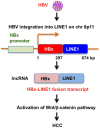Guardian of the Human Genome: Host Defense Mechanisms against LINE-1 Retrotransposition
- PMID: 27446907
- PMCID: PMC4924340
- DOI: 10.3389/fchem.2016.00028
Guardian of the Human Genome: Host Defense Mechanisms against LINE-1 Retrotransposition
Abstract
Long interspersed element type 1 (LINE-1, L1) is a mobile genetic element comprising about 17% of the human genome, encoding a newly identified ORF0 with unknown function, ORF1p with RNA-binding activity and ORF2p with endonuclease and reverse transcriptase activities required for L1 retrotransposition. L1 utilizes an endonuclease (EN) to insert L1 cDNA into target DNA, which induces DNA double-strand breaks (DSBs). The ataxia-telangiectasia mutated (ATM) is activated by DSBs and subsequently the ATM-signaling pathway plays a role in regulating L1 retrotransposition. In addition, the host DNA repair machinery such as non-homologous end-joining (NHEJ) repair pathway is also involved in L1 retrotransposition. On the other hand, L1 is an insertional mutagenic agent, which contributes to genetic change, genomic instability, and tumorigenesis. Indeed, high-throughput sequencing-based approaches identified numerous tumor-specific somatic L1 insertions in variety of cancers, such as colon cancer, breast cancer, and hepatocellular carcinoma (HCC). In fact, L1 retrotransposition seems to be a potential factor to reduce the tumor suppressive property in HCC. Furthermore, recent study demonstrated that a specific viral-human chimeric transcript, HBx-L1, contributes to hepatitis B virus (HBV)-associated HCC. In contrast, host cells have evolved several defense mechanisms protecting cells against retrotransposition including epigenetic regulation through DNA methylation and host defense factors, such as APOBEC3, MOV10, and SAMHD1, which restrict L1 mobility as a guardian of the human genome. In this review, I focus on somatic L1 insertions into the human genome in cancers and host defense mechanisms against deleterious L1 insertions.
Keywords: DNA double-strand breaks (DSBs); DNA repair; HBV; LINE-1; epigenetic regulation; retrotransposition; somatic insertion; tumor suppressor.
Figures



Similar articles
-
DNA repair protein Rad18 restricts LINE-1 mobility.Sci Rep. 2018 Oct 26;8(1):15894. doi: 10.1038/s41598-018-34288-9. Sci Rep. 2018. PMID: 30367120 Free PMC article.
-
Immune signatures correlate with L1 retrotransposition in gastrointestinal cancers.Genome Res. 2018 Aug;28(8):1136-1146. doi: 10.1101/gr.231837.117. Epub 2018 Jul 3. Genome Res. 2018. PMID: 29970450 Free PMC article.
-
Endonuclease-independent LINE-1 retrotransposition at mammalian telomeres.Nature. 2007 Mar 8;446(7132):208-12. doi: 10.1038/nature05560. Nature. 2007. PMID: 17344853
-
Post-Transcriptional Control of LINE-1 Retrotransposition by Cellular Host Factors in Somatic Cells.Front Cell Dev Biol. 2016 Mar 7;4:14. doi: 10.3389/fcell.2016.00014. eCollection 2016. Front Cell Dev Biol. 2016. PMID: 27014690 Free PMC article. Review.
-
The Role of Somatic L1 Retrotransposition in Human Cancers.Viruses. 2017 May 31;9(6):131. doi: 10.3390/v9060131. Viruses. 2017. PMID: 28561751 Free PMC article. Review.
Cited by
-
Proteome Profile of Endogenous Retrotransposon-Associated Complexes in Human Embryonic Stem Cells.Proteomics. 2019 Aug;19(15):e1900169. doi: 10.1002/pmic.201900169. Epub 2019 Jul 18. Proteomics. 2019. PMID: 31219246 Free PMC article.
-
Opposing roles of pseudokinases NRBP1 and NRBP2 in regulating L1 retrotransposition.Nat Commun. 2025 Jul 11;16(1):6327. doi: 10.1038/s41467-025-61626-z. Nat Commun. 2025. PMID: 40645931 Free PMC article.
-
The reconstruction of evolutionary dynamics of processed pseudogenes indicates deep silencing of "retrobiome" in naked mole rat.Proc Natl Acad Sci U S A. 2024 Nov 5;121(45):e2313581121. doi: 10.1073/pnas.2313581121. Epub 2024 Oct 28. Proc Natl Acad Sci U S A. 2024. PMID: 39467133 Free PMC article.
-
ZCCHC3 is a stress granule zinc knuckle protein that strongly suppresses LINE-1 retrotransposition.PLoS Genet. 2023 Jul 5;19(7):e1010795. doi: 10.1371/journal.pgen.1010795. eCollection 2023 Jul. PLoS Genet. 2023. PMID: 37405998 Free PMC article.
-
HIV-1 Vpr and p21 restrict LINE-1 mobility.Nucleic Acids Res. 2018 Sep 19;46(16):8454-8470. doi: 10.1093/nar/gky688. Nucleic Acids Res. 2018. PMID: 30085096 Free PMC article.
References
-
- Armanios M., Chen J. L., Chang Y. P., Brodsky R. A., Hawkins A., Griffin C. A., et al. . (2005). Haploinsufficiency of telomerase reverse transcriptase leads to anticipation in autosomal dominant dyskeratosis congenital. Proc. Natl. Acad. Sci. U.S.A. 102, 15960–15964. 10.1073/pnas.0508124102 - DOI - PMC - PubMed
Publication types
LinkOut - more resources
Full Text Sources
Other Literature Sources
Research Materials
Miscellaneous

